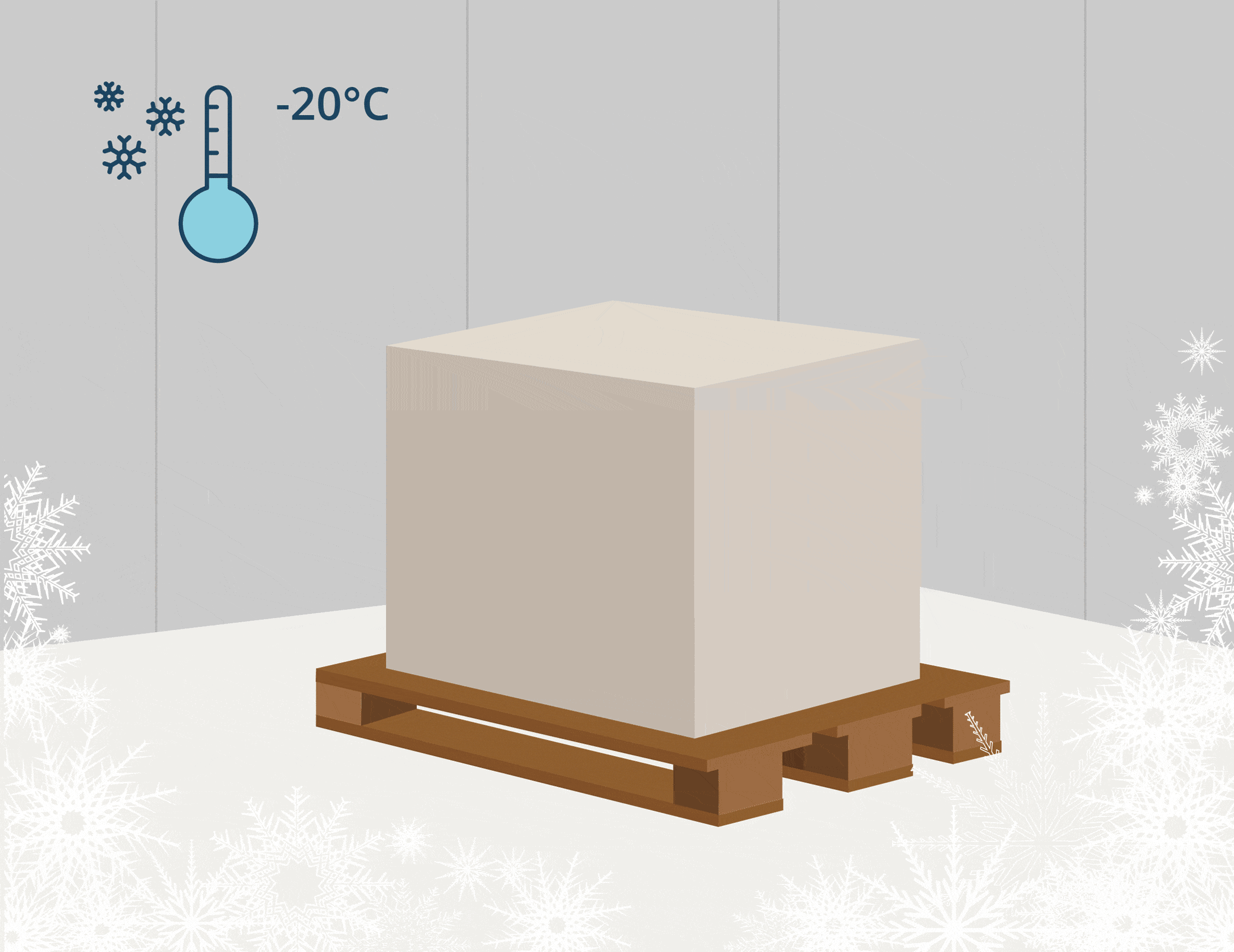Standardized climatic tests: Heat and cold. Constant and changing
No one can choose the weather, but definitely the best packaging for products!
But this does not answer all our questions, because: What happens to the products under changing climatic conditions? For example: When products are exposed to particularly low temperatures and then become damp. As a result, ice formation or condensation can damage the products. If they are exposed to particularly high heat, the plastic could melt or the product could spoil.
Unique in northern Germany: A 24 m² climate chamber
The test procedures differ significantly: on the one hand we can work with constant climate, on the other hand there are test options with alternating climate conditions. If the sample is exposed to a constant climate, this usually means that the climate penetrates into every area of the test sample. A frequent specification in test procedures is therefore an exposure time of 72 hours.
Climate change tests, on the other hand, have a different focus. Here, the aim is to simulate shipping conditions. These tests, called temperature studies, are of particular interest to customers who are active in the medical field and want to qualify their packaging systems. For example, manufacturers of medical packaging or vaccines.
When we simulate a shipping process, we do so with the help of strategically placed sensors called temperature and climate sensors. These check whether all sensors have the same temperature after the test. If this is the case: Great, that tells us that the selected packaging is suitable, for example, for shipping medications at a specified temperature.

Change of temperature from 10°C to 50°C in only eight minutes
Standards: Climate tests
- DIN ISO 9022-2: Optics and optical instruments; environmental test methods; part 2: cold, heat, humidity
- DIN EN 60068-2-1: Environmental testing; Part 2: Testing; Test group A: Cold
- DIN EN 60068-2-2: Environmental testing; Part 2: Testing; Test group B: Dry heat
- DIN EN 60068-2-2/A2: Environmental tests; Part 2: Tests; Test group B: Dry heat
- DIN EN 60068-2-14: Environmental tests – Part 2: Tests; Test N: Thermal cycling
- DIN EN 60068-2-17: Environmental tests; Part 2: Tests; Test Q: Tightness
- DIN EN 60068-2-18: Environmental tests – Part 2-18: Tests, test R and guide: Water
- DIN EN 60068-2-30: Environmental tests – Part 2-30: Test methods – Test Db: Damp heat, cyclic (12 + 12 hours)
- DIN EN 60068-2-33: Environmental tests – Part 2: Tests; Guide to test group N: Thermal cycling
- DIN EN 60068-2-38: Environmental tests – Part 2: Tests; Test Z/AD: Composite test, temperature/humidity, cyclic
- DIN EN 60068-3-1: Umweltprüfungen – Teil 3: Leitfäden; Hauptabschnitt 1: Prüfungen mit Kälte und trockener Wärme
- DIN EN 60068-3-4: Umweltprüfungen – Teil 3-4: Unterstützende Dokumentation und Leitfaden; Prüfungen mit feuchter Wärme
- ASTM D4332-22: Standard Practice for Conditioning Containers, Packages, or Packaging Components for Testing
- MIL STD- 810 F: Department of Defence (USA); Test Method Standard for Environmental Engineering Considerations and Laboratory Tests
- Method 501.4: High Temperature
- Method 502.4: Low Temperature
- Method 507.4: HumidityRTCA DO 160 E 2004-12: Environmental Conditions and Test Procedures for Airborne Equipment
- Section 5.0: Temperature Variation
- Section 6.0: Humidity
- EUROCAE ED-14E: Environmental Conditions and Test Procedures for Airborne Equipment
- Section 5.0: Temperature Variation
- Section 6.0: Humidity
- DNVGL-CG-0339: Dry heat test, Damp heat test, Cold test
Equipment: climatic chambers
Test chamber: (6.0 x 4.0 x 3.0) m
Temperature range: -40 °C to +80 °C
Climatic working range: +10 °C to +60 °C
relative humidity: 30 % to 98 %
Walk-in climatic chamber 2
Test chamber: (3.9 x 3.3 x 2.0) m
Door: (1.19 x 1.99) m
Temperature range: +10 °C to +60 °C
climatic working range: +10 °C to +60 °C
relative humidity: 30 % to 95
Walk-in climatic chamber 3
Test chamber: (2,25 x 2,25 x 2,05) m
Door: (0.88 x 1.89) m
Temperature range: -20 °C to +70 °C
climatic range: +10 °C to +60 °C
Relative humidity: 30% to 95%.
Test chamber: (2,6 x 1,6 x 2,1) m
Door: (2,5 x 2,1) m
Temperature working range: -50 °C to +60 °C
climatic range: +10 °C to +60 °C
relative humidity: 10 % to 95
Climatic chamber 4
Test chamber: (1.0 x 1.0 x 1.0) m
Temperature operating range: +10 °C to +60 °C
climatic range: +10 °C to +60 °C
Relative humidity: 30 % to 95 %
Request a quote
In order to submit the appropriate offer, we need the following information:
- Number, weight and dimensions of the samples
- Duration of air conditioning (tolerance of the climate in +- °C / +- % relative humidity).
- Are there any standards to be complied with?
Your contacts

Karolina Behrens
Dipl.-Ing.
Head of Laboratory for Shipping Simulation
040 / 5730 944 -27

Johanna Lipski
M. Sc.
Deputy Head of Laboratory for Shipping Simulation
040 / 5730 944 -26
We find answers to your questions
We provide expertise, focus on packaging and find answers to your questions - authentically, honestly, competently and without digressing. So that we can answer your questions, test your products and expand your knowledge of packaging, send us your e-mail address and we will get back to you.
We look forward to your individual challenge!

Our accreditation & certifications

Accreditation
The German Accreditation Body (DAkkS)
is the national accreditation authority
of the Federal Republic of Germany.

Certification

